ABSTRACT
It is known that the active properties of a nanocomposite can be changed by introducing various nanosized particles matrix possessing luminescent, magnetic, photovoltaic,
photoresistive and other active properties into the polymer. However, due to the fact that the systematic analysis of above-mentioned properties properties of polymer-based
nanocomposites modified with metal oxide nanoparticles is not fully carried out, it is important to continue research in this area, both experimentally and theoretically.
The presented article is devoted to the production of thermoplastic polymer-based nanocomposites modified with oxide nanoparticles and the study of photoluminescence and
electret properties.
Keywords: nanocomposite, nanoparticles, electret, photoluminescence
PACS: 42.70.Jk, 78.55.−m, 81.07.Nb
DOI:-
Received: 26.10.2021
AUTHORS & AFFILIATIONS
Baku State University, 23, Z. Khalilov st., Baku, AZ 1148, Azerbaijan
E-mail: rahimli.almara@gmail.com
|
REFERENCIES
[1] G. Sessler and R. Gerhard-Multhaupt. Electrets: 3rd Ed., Laplacian Press, Morgan Hill, California, USA, 1999.
[2] N. Kestelman. Electrets in engineering: Fundamentals and applications. Springer, 2000.
[3] M. Goel. Electret sensors, filters and MEMS devices: New challenges in materials research. Current science, 2005, vol. 85, № 4, pp. 443-453.
[4] J. Giacometti, S. Fedosov and M. Costa. Brazilian J. Phys., 1999, vol. 29, № 2, pp. 269-279.
[5] J.A. Giacometti and O.N. Oliveira. Corona charging of polymers. IEEE Trans. Electr. Insul., 1992, vol. 27, № 5, pp. 924-943.
[6] D.Faust etc. Investigations into the reliability of electrophotography. 1975.
[7] A.E.Job, J.A. Giacometti, and L.H. Mattoso. Applied Physics Letters, 1998, 72(25), 3279-3281.
[8] S. Sapieha, J. Cernyand, L. Martinu. 1993, The Journal of Adhesion, 42(1-2), 91-102.
[9] M. Galikhanov, A. Borisova and R. Deberdeev. Russian J. Appl. Chem., 2005, vol. 78, № 5, pp. 820-823.
[10] N. Mohmeyeretc. Additives to improve the electret properties of isotactic polypropylene. Polymer, 2007, vol. 48, pp. 1612-1619.
[11] C. Reedyk and M. Perlman.The measurement of surface charge. J. Electrochem. Soc., 1968, vol. 115, № 1, pp. 49-51.
[12] L. Pinchuketc. Engineering composite electrets material. 11th Int’l. Conf. Composite Materials, 1997, pp. 859-869
[13] M.A. Ramazanov, A.S. Guseinova. Surface Engineering and Applied Electrochemistry, 2013, 49 (2), p. 97-100.
[14] G.M. Sessler. Electrets: recent developments. J. Electrostat., 2001, vol. 51-52, p.137-145.
[15] R. Jourdainetc. New materials for micro-scale sensors and actuators: An engineering review. Materials Sci. and Engineering: R: Reports, vol.56, № 1-6, 2007, pp. 1–129
[16] B. Kulyka etc.. J. Alloys and Compounds, vol. 502, 2010, pp. 24–27
[17] J. Zhaetc. J. Electrostat., vol. 69, 2011, pp. 255-260.
[18] A. Viraneva etc. Effect of TiO2 particle incor-poration on the electret properties of corona charged polypropylene composite films. Bulg. Chem. Communications, 2013, vol. 45, №. B, pp. 73-76.
[19] A. Mills. Journal of Photochemistry and Photobiology A:Chemistry, 1997, 108(1),1-35
[20] A. L. Linsebigler. Chemical Reviews, 1995, 95(3), 735-758.
[21] M. Anpo, Research on Chemical Intermediates, 1989, 11(1), 67-106.
[22] T. Kazashka and T. Yovcheva. Composite electret's films on the base of the polylactic acid. University of Plovdiv, “Paisii Hilendarski”, Scientific studies, Physics, 2013, vol. 38.
[23] A. Viraneva, T. Yovcheva and M. Galikhanov. Electret properties of PP/ZnO and PP/CuO composite films. IEEE Transactions on Dielectrics and Electrical Insulation, 2015, vol. 22, № 3, pp. 1343-1348.
[24] Xia Zhongfu.Influence of quenching on the charge stability of polymer electrets. 6th International Symposium on Electrets, (ISE 6) Proceedings.
[25] Thermold Design And Development Inc Wilson Nc. 1981. Final progress report on contract DAAK10-79-C-0403 (Thermold design and development, Inc).
[26] Р.М. Асеева, Г.Е. Заиков. Горение полимерных материалов. М.: Химия, 1981, 280 с.
[27] A.I. Gubkin. Electrets. Nauka: Moscow, 1978, 13.
[28] G.A. Lushcheikin. Polymer Electrets. Nauka: Moscow, 1976.
[29] Y.A. Gorokhvatskii. Basics of Thermal Depolarization Analysis. Nauka: Moscow, 1981.
[30] F. Gutmann. The Electret. Reviews of Modern Physics, 20(3), 1948, 457–472.
[31] А.М. Магеррамов. Электрические процессы в технике и химии, 2011, т. 47, № 5, с. 60-64.
[32] Jl. А.Костандов и др. Способ получения композиционного материала. Х. М. А., Авт. Свид. СССР 763379; Бюл. изобр., № 34, 1980, с. 129.
[33] S. Bazhenov. J. Mater. Sci., 1997, v. 32, p. 797-802.
[34] A. Kravtsov etc. Advances in Polymer Technology, 2000, 19(4), 312–316.
[35] M. Ramazanov etc. Acta Physica Polonica A, 2017, 131(6), 1540-1543.
[36] N.D. Abazovic etc. The Journal of Physical Chemistry B, 2006, 110(50), 25366-25370.
[37] S. Zhangetc. Fluorescence enhancement of quantum dots from the titanium dioxide/liquid crystals/polymer composite films. Liquid Crystals, 48(3), 2020, 322-335.
|
